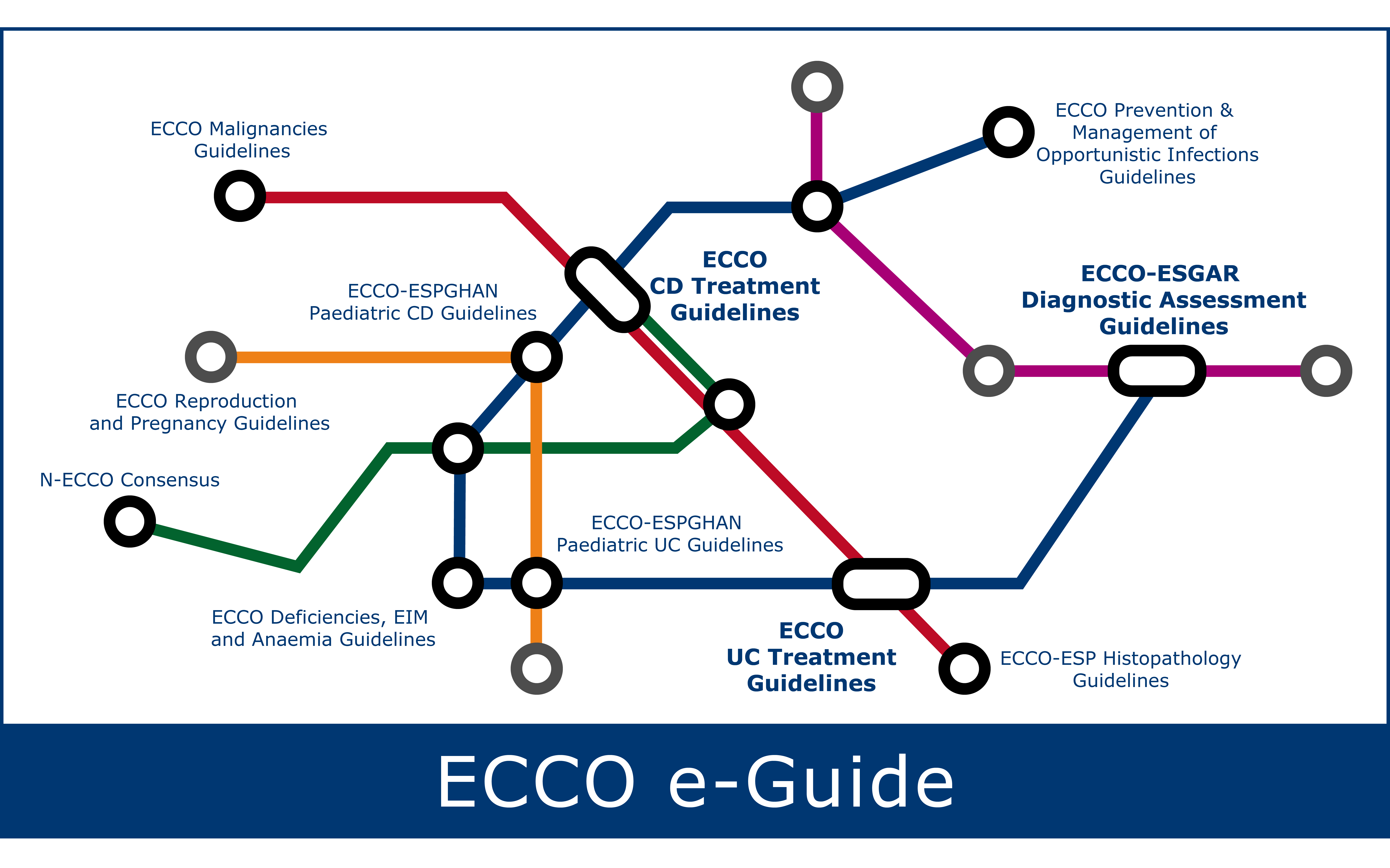The information below is based on the summary of product characteristics approved by regulatory authorities. For full details from the SmPC, please click here https://www.medicines.org.uk/emc/product/7986/smpc
Additional related ECCO e-Learning resources can be found under IBD Curriculum Topic 6.1-6.11
Introduction and Mechanism of Action
Adalimumab is a recombinant human IgG1 monoclonal antibody specific for human tumour necrosis factor (TNF).Adalimumab binds specifically to TNF and neutralises the biological function of TNF by blocking its interaction with the p55 and p75 cell surface TNF receptors. Adalimumab also modulates biological responses that are induced or regulated by TNF, including changes in the levels of adhesion molecules responsible for leukocyte migration (ELAM-1, VCAM-1, and ICAM-1 with an IC50 of 0.1-0.2 nM).
Therapeutic indications
Crohn's Disease: Adalimumab is indicated for treatment of moderately to severely active Crohn's disease, in adult patients who have not responded despite a full and adequate course of therapy with a corticosteroid and/or an immunosuppressant; or who are intolerant to or have medical contraindications for such therapies.
Paediatric Crohn's Disease: Adalimumab is indicated for the treatment of moderately to severely active Crohn's disease in paediatric patients (from 6 years of age) who have had an inadequate response to conventional therapy including primary nutrition therapy and a corticosteroid and/or an immunomodulator, or who are intolerant to or have contraindications for such therapies.
Ulcerative Colitis: Adalimumab is indicated for treatment of moderately to severely active ulcerative colitis in adult patients who have had an inadequate response to conventional therapy including corticosteroids and 6-mercaptopurine (6-MP) or azathioprine (AZA), or who are intolerant to or have medical contraindications for such therapies.
Dosing, administration
Crohn's Disease: The recommended Adalimumab induction dose regimen for adult patients with moderately to severely active Crohn's disease is 80 mg at Week 0 followed by 40 mg at Week 2. In case there is a need for a more rapid response to therapy, the regimen 160 mg at Week 0,80 mg at Week 2 can be used with the awareness that the risk for adverse events is higher during induction.
After induction treatment, the recommended dose is 40 mg every other week via subcutaneous injection.
Some patients who experience decrease in their response to adalimumab 40 mg every other week may benefit from an increase in dosage to 40 mg adalimumab every week or 80 mg every other week.
Ulcerative Colitis: The recommended adalimumab induction dose regimen for adult patients with moderate to severe ulcerative colitis is 160 mg at Week 0 and 80 mg at Week 2. After induction treatment, the recommended dose is 40 mg every other week via subcutaneous injection.
Some patients who experience decrease in their response to 40 mg every other week may benefit from an increase in dosage to 40 mg adalimumab every week or 80 mg every other week.
Contraindications
Hypersensitivity to the active substance, to other murine proteins, or to any of the excipients listed in section 6.1 (List of Excipients) of the full SmPC
Patients with tuberculosis or other severe infections such as sepsis, abscesses, and opportunistic infections
Patients with moderate or severe heart failure (NYHA class III/IV)
Adverse effects
The most commonly reported adverse reactions are infections (such as nasopharyngitis, upper respiratory tract infection and sinusitis), injection site reactions (erythema, itching, haemorrhage, pain or swelling), headache and musculoskeletal pain.
Fatal and life-threatening infections (including sepsis, opportunistic infections and TB), HBV reactivation and various malignancies (including leukaemia, lymphoma and HSTCL) have also been reported with use of adalimumab.
Serious haematological, neurological and autoimmune reactions have also been reported. These include rare reports of pancytopenia, aplastic anaemia, central and peripheral demyelinating events and reports of lupus, lupus-related conditions and Stevens-Johnson syndrome.
Paediatric population
In general, the adverse events in paediatric patients were similar in frequency and type to those seen in adult patients.
The following list of adverse reactions is based on experience from clinical trials and on post-marketing experience and are displayed by system organ class and frequency in the table below: very common (≥ 1/10); common (≥ 1/100 to < 1/10); uncommon (≥ 1/1,000 to < 1/100); rare (≥ 1/10,000 to < 1/1,000); and not known (cannot be estimated from the available data). Within each frequency grouping, undesirable effects are presented in order of decreasing seriousness.
|
Undesirable Effects |
||
|
System Organ Class |
Frequency |
Adverse Reaction |
|
Infections and infestations* |
Very common |
Respiratory tract infections (including lower and upper respiratory tract infection, pneumonia, sinusitis, pharyngitis, nasopharyngitis and pneumonia herpes viral) |
|
Common |
Systemic infections (including sepsis, candidiasis and influenza), intestinal infections (including gastroenteritis viral), skin and soft tissue infections (including paronychia, cellulitis, impetigo, necrotising fasciitis and herpes zoster), ear infections, oral infections (including herpes simplex, oral herpes and tooth infections), reproductive tract infections (including vulvovaginal mycotic infection), urinary tract infections (including pyelonephritis), fungal infections, joint infections |
|
|
Uncommon |
Neurological infections (including viral meningitis), opportunistic infections and tuberculosis (including coccidioidomycosis, histoplasmosis and mycobacterium avium complex infection), bacterial infections, eye infections, diverticulitis1) |
|
|
Neoplasms benign, malignant and unspecified (including cysts and polyps)* |
Common |
Skin cancer excluding melanoma (including basal cell carcinoma and squamous cell carcinoma), benign neoplasm |
|
Uncommon |
Lymphoma**, solid organ neoplasm (including breast cancer, lung neoplasm and thyroid neoplasm), melanoma** |
|
|
|
Rare |
Leukaemia1) |
|
Not known |
Hepatosplenic T-cell lymphoma1) Merkel cell carcinoma (neuroendocrine carcinoma of the skin)1) |
|
|
Blood and the lymphatic system disorders* |
Very common |
Leukopenia (including neutropenia and agranulocytosis), anaemia |
|
Common |
Leucocytosis, thrombocytopenia |
|
|
Uncommon |
Idiopathic thrombocytopenic purpura |
|
|
Rare |
Pancytopenia |
|
|
Immune system disorders* |
Common |
Hypersensitivity, allergies (including seasonal allergy) |
|
Uncommon |
Sarcoidosis1), vasculitis |
|
|
Rare |
Anaphylaxis1) |
|
|
Metabolism and nutrition disorders |
Very common |
Lipids increased |
|
Common |
Hypokalaemia, uric acid increased, blood sodium abnormal, hypocalcaemia, hyperglycaemia, hypophosphatemia, dehydration |
|
|
Psychiatric disorders |
Common |
Mood alterations (including depression), anxiety, insomnia |
|
Nervous system disorders* |
Very common |
Headache |
|
Common |
Paraesthesias (including hypoesthesia), migraine, nerve root compression |
|
|
Uncommon |
Cerebrovascular accident1), tremor, neuropathy |
|
|
Rare |
Multiple sclerosis, demyelinating disorders (e.g. optic neuritis, Guillain-Barré syndrome)1) |
|
|
Eye disorders |
Common |
Visual impairment, conjunctivitis, blepharitis, eye swelling |
|
Uncommon |
Diplopia |
|
|
Ear and labyrinth disorders |
Common |
Vertigo |
|
Uncommon |
Deafness, tinnitus |
|
|
Cardiac disorders* |
Common |
Tachycardia |
|
Uncommon |
Myocardial infarction1), arrhythmia, congestive heart failure |
|
|
Rare |
Cardiac arrest |
|
|
Vascular disorders |
Common |
Hypertension, flushing, haematoma |
|
Uncommon |
Aortic aneurysm, vascular arterial occlusion, thrombophlebitis |
|
|
Respiratory, thoracic and mediastinal disorders* |
Common |
Asthma, dyspnoea, cough |
|
Uncommon |
Pulmonary embolism1), interstitial lung disease, chronic obstructive pulmonary disease, pneumonitis, pleural effusion1) |
|
|
Rare |
Pulmonary fibrosis1) |
|
|
Gastrointestinal disorders |
Very common |
Abdominal pain, nausea and vomiting |
|
Common |
GI haemorrhage, dyspepsia, gastroesophageal reflux disease, sicca syndrome |
|
|
Uncommon |
Pancreatitis, dysphagia, face oedema |
|
|
Rare |
Intestinal perforation1) |
|
|
Hepato-biliary disorders* |
Very Common |
Elevated liver enzymes |
|
Uncommon |
Cholecystitis and cholelithiasis, hepatic steatosis, bilirubin increased |
|
|
Rare |
Hepatitis reactivation of hepatitis B1) autoimmune hepatitis1) |
|
|
Not known |
Liver failure1) |
|
|
Skin and subcutaneous tissue disorders |
Very Common |
Rash (including exfoliative rash) |
|
Common |
Worsening or new onset of psoriasis(including palmoplantar pustular psoriasis)1), urticaria, bruising (including purpura), dermatitis (including eczema), onychoclasis, hyperhidrosis, alopecia1), pruritus |
|
|
Uncommon |
Night sweats, scar |
|
|
Rare |
Erythema multiforme1), Stevens-Johnson syndrome1), angioedema1), cutaneous vasculitis1) lichenoid skin reaction1) |
|
|
Not known |
Worsening of symptoms of dermatomyositis1) |
|
|
Musculoskeletal and connective tissue disorders |
Very common |
Musculoskeletal pain |
|
Common |
Muscle spasms (including blood creatine phosphokinase increased) |
|
|
Uncommon |
Rhabdomyolysis, systemic lupus erythematosus |
|
|
Rare |
Lupus-like syndrome1) |
|
|
Renal and urinary disorders |
Common |
Renal impairment, haematuria |
|
Uncommon |
Nocturia |
|
|
Reproductive system and breast disorders |
Uncommon |
Erectile dysfunction |
|
General disorders and administration site conditions* |
Very Common |
Injection site reaction (including injection site erythema) |
|
Common |
Chest pain, oedema, pyrexia1) |
|
|
Uncommon |
Inflammation |
|
|
Investigations* |
Common |
Coagulation and bleeding disorders (including activated partial thromboplastin time prolonged), autoantibody test positive (including double stranded DNA antibody), blood lactate dehydrogenase increased |
|
Injury, poisoning and procedural complications |
Common |
Impaired healing |
* further information is found elsewhere in sections 4.3, 4.4 and 4.8 of the full SmPC
** including open label extension studies
1) including spontaneous reporting data
Interactions with other Drugs
The combination of adalimumab and anakinra is not recommended (see section 4.4 of the full SmPC “Concurrent administration of biologic DMARDS or TNF-antagonists”).
The combination of adalimumab and abatacept is not recommended (see section 4.4 of the full SmPC “Concurrent administration of biologic DMARDS or TNF-antagonists”).
Live vaccine should not be administered to patients receiving adalimumab.
Special situations
Women of child bearing potential
Women of childbearing potential should consider the use of adequate contraception to prevent pregnancy and continue its use for at least five months after the last adalimumab treatment.
Pregnancy
A large number (approximately 2100) of prospectively collected pregnancies exposed to adalimumab resulting in live birth with known outcomes, including more than 1500 exposed during the first trimester, does not indicate an increase in the rate of malformation in the newborn.
Due to its inhibition of TNFα, adalimumab administered during pregnancy could affect normal immune responses in the newborn. Adalimumab should only be used during pregnancy if clearly needed.
Breast-feeding
Adalimumab is excreted in breast milk at very low concentrations Given orally, immunoglobulin G proteins undergo intestinal proteolysis and have poor bioavailability. No effects on the breastfed newborns/infants are anticipated. Consequently, adalimumab can be used during breastfeeding.
Fertility
Preclinical data on fertility effects of adalimumab are not available.

